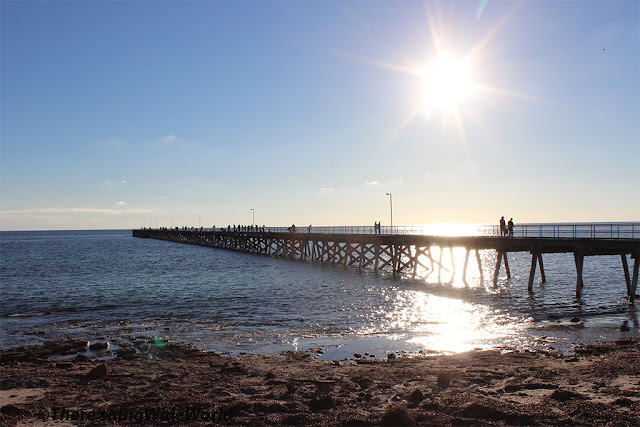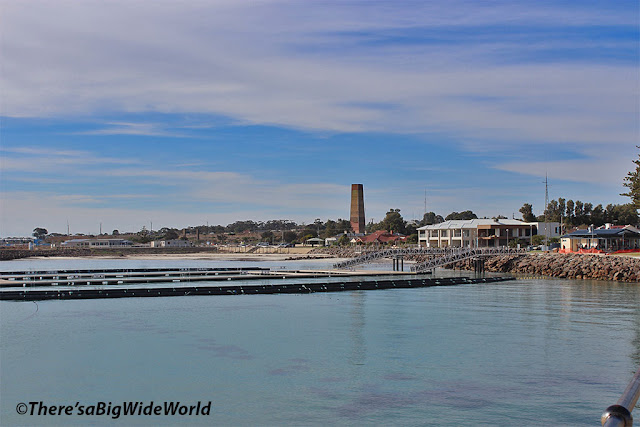Or alternatively Australia's 'Little Cornwall'
Just 2 hours drive north of Adelaide are a group of small towns that owe their existence to the discovery of copper in the area. The state of South Australia to an extent owes its existence to the discovery of copper in the mid 1800s as it rescued the state from its money woes.Why 'Little Cornwall'? Well the miners who came out to work in the mines were from Cornwall, they brought along their skills and traditions. This is the place to get your Cornish pastie! When the mining of copper was no longer viable these towns survived as ports or to support the local farming industry and now as tourist towns.
Port Hughes jetty, it had been a sleepy little village with a jetty until holiday makers discovered it and now there are large double storey holiday homes in the town.
There are still remnants of that small seaside location with the tavern, the petrol pumps out the front and a store.
The largest copper deposits were found in the area that became known as Moonta. Copper ore was found in a wombat burrow, the state has a lot to thank that wombat for! As miners came to the area, businesses set themselves up to supply the miners, the town of Moonta was a commercial centre not residential as miners tended to live on their holdings. For a small country town in South Australia, it has a number of substantial buildings reflecting the prosperity that was around.
Moonta Uniting Church (former Methodist church)
Moonta Bay from the jetty, revisiting a childhood holiday location! A lot more housing! We stayed in the caravan park and it wasn't quite so built up!
Kadina which is not on the coast, is the largest town in the region. It was also established due to the copper mines nearby, confusingly called the Wallaroo mines even though they weren't at Wallaroo. (which had no copper mines!)
Wallaroo had the smelters to convert the ore to metal and a deep water port to export it all. When the price of copper fell, the smelters weren't viable anymore so they were closed and demolished. All that's left above ground is this chimney. The workers at the smelters were Welsh so the chimneys they built were square, the miners who were encouraged to come from Cornwall, built the chimneys they were used to, round ones. I know far too much about industrial chimneys thanks to travelling in South Australia! I've been to Cornwall and saw the chimneys there and thought 'It's true they did built round ones!'
Wallaroo jetty, still a working industrial jetty as there are grain silos next to it. The long white tube on the left is how the grain is loaded on the ships from the silos.
Looking back to the swimming area from the jetty. Behind the swimming area is 'Office Beach' it's called that as it's infront of the building that was the smelter's office. The smelters closed in 1923 but the name remained, the office is now a Heritage B&B.
Even in winter the Wallaroo sunsets are stunning. Sun setting behind the swimming enclosure and jetty.
Just 2 hours drive north of Adelaide are a group of small towns that owe their existence to the discovery of copper in the area. The state of South Australia to an extent owes its existence to the discovery of copper in the mid 1800s as it rescued the state from its money woes.Why 'Little Cornwall'? Well the miners who came out to work in the mines were from Cornwall, they brought along their skills and traditions. This is the place to get your Cornish pastie! When the mining of copper was no longer viable these towns survived as ports or to support the local farming industry and now as tourist towns.
Port Hughes jetty, it had been a sleepy little village with a jetty until holiday makers discovered it and now there are large double storey holiday homes in the town.
There are still remnants of that small seaside location with the tavern, the petrol pumps out the front and a store.
The largest copper deposits were found in the area that became known as Moonta. Copper ore was found in a wombat burrow, the state has a lot to thank that wombat for! As miners came to the area, businesses set themselves up to supply the miners, the town of Moonta was a commercial centre not residential as miners tended to live on their holdings. For a small country town in South Australia, it has a number of substantial buildings reflecting the prosperity that was around.
Moonta Uniting Church (former Methodist church)
Moonta Bay from the jetty, revisiting a childhood holiday location! A lot more housing! We stayed in the caravan park and it wasn't quite so built up!
Kadina which is not on the coast, is the largest town in the region. It was also established due to the copper mines nearby, confusingly called the Wallaroo mines even though they weren't at Wallaroo. (which had no copper mines!)
Wallaroo had the smelters to convert the ore to metal and a deep water port to export it all. When the price of copper fell, the smelters weren't viable anymore so they were closed and demolished. All that's left above ground is this chimney. The workers at the smelters were Welsh so the chimneys they built were square, the miners who were encouraged to come from Cornwall, built the chimneys they were used to, round ones. I know far too much about industrial chimneys thanks to travelling in South Australia! I've been to Cornwall and saw the chimneys there and thought 'It's true they did built round ones!'
Wallaroo jetty, still a working industrial jetty as there are grain silos next to it. The long white tube on the left is how the grain is loaded on the ships from the silos.
Looking back to the swimming area from the jetty. Behind the swimming area is 'Office Beach' it's called that as it's infront of the building that was the smelter's office. The smelters closed in 1923 but the name remained, the office is now a Heritage B&B.
Even in winter the Wallaroo sunsets are stunning. Sun setting behind the swimming enclosure and jetty.










Comments
Post a Comment